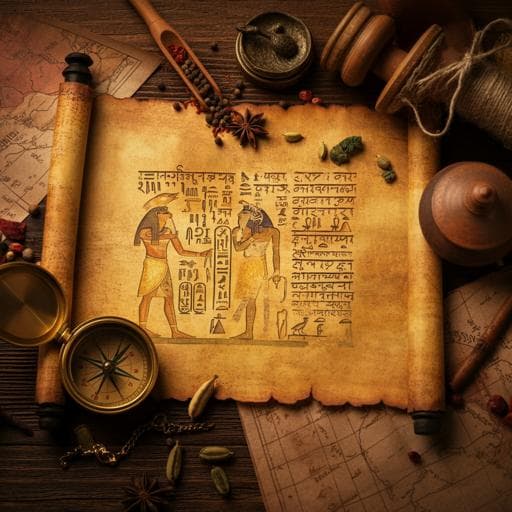
Linguistics and Languages
Linguistic borrowings in trade terminologies: an analysis of ancient Indian and Egyptian languages from 3300 BCE to 500 CE
P. Mohanan and N. Prakash
Dive into the intriguing world of ancient linguistic connections! This research explores the fascinating trade terminologies between ancient Indian languages and Egyptian scripts, revealing unexpected cultural exchanges that shaped communication in commerce. Conducted by Pallavi Mohanan and Nirupama Prakash, this study sheds light on the rich tapestry of ancient trade networks.
~3 min • Beginner • English
Introduction
The study of linguistic borrowings in trade terminologies between ancient Indian and Egyptian languages offers a unique window into the complex tapestry of cultural and economic exchanges that characterized the period from 3300 BCE to 500 CE. This research endeavours to unravel the intricate connections between language, commerce, and cultural diffusion along the trade routes that linked these two great civilizations. By examining linguistic evidence from a diverse array of sources, including inscriptions, papyri, and classical texts, we aim to shed light on the nature and extent of lexical borrowings in the domain of trade and commerce.
The significance of this study lies in its potential to enhance our understanding of the mechanisms of linguistic and cultural exchange in antiquity. As Trautmann (2006) posits, the analysis of lexical borrowings can provide invaluable insights into the nature and intensity of cross-cultural contacts. In the context of Indo-Egyptian relations, such an analysis becomes particularly pertinent, given the historical importance of trade connections between these regions and their role in shaping broader patterns of cultural and technological diffusion across the ancient world.
Our research seeks to address several key objectives. Firstly, we aim to identify and analyse specific instances of linguistic borrowings in trade terminologies between ancient Indian languages (primarily Sanskrit and Prakrits) and Egyptian (including both hieroglyphic and demotic forms). Secondly, we intend to contextualize these borrowings within the broader framework of economic and cultural exchanges between India and Egypt during the specified time period. Finally, we aspire to contribute to ongoing scholarly debates regarding the nature and extent of direct and indirect contacts between these civilizations.
It is crucial to acknowledge the formidable challenges inherent in this type of historical linguistic analysis. The vast temporal scope of our study, spanning nearly four millennia, necessitates careful consideration of the evolving nature of both languages and trade practices over time. Moreover, the fragmentary nature of available evidence and the complexities of interpreting ancient texts and inscriptions pose significant methodological hurdles. As Biagi et al. (2021) note, the reconstruction of ancient trade networks requires a multidisciplinary approach, combining linguistic, archaeological, and historical evidence.
The importance of understanding linguistic exchanges in the context of ancient trade relations cannot be overstated. Language, as a primary vehicle of cultural transmission, plays a crucial role in facilitating economic interactions and shaping perceptions of foreign cultures. By examining the adoption and adaptation of trade terminologies across linguistic boundaries, we can gain valuable insights into the dynamics of cross-cultural communication and the processes of knowledge transfer in antiquity.
Recent scholarship has highlighted the need for more nuanced approaches to the study of ancient trade networks and their linguistic implications. Dietler and López-Ruiz (2009) emphasizes the importance of considering both direct and indirect trade connections, as well as the role of intermediary cultures in facilitating linguistic and cultural exchanges. Our research builds upon these insights, adopting a comprehensive approach that considers not only direct evidence of linguistic borrowings but also the broader contextual factors that may have influenced language contact and lexical adoption.
It is important to note that the study of ancient languages and trade connections is fraught with complexities and limitations. The scarcity of primary sources, the challenges of accurate dating, and the potential for misinterpretation of linguistic evidence all serve to complicate our analysis. Furthermore, the possibility of coincidental similarities between languages or independent parallel developments must be carefully considered when evaluating potential borrowings.
Despite these challenges, this research has the potential to make significant contributions to multiple fields of study. In the realm of linguistics, it offers insights into the mechanisms of lexical borrowing and the adaptation of foreign terminology in specialized domains. For archaeologists and historians, our findings may provide valuable clues about the nature and intensity of trade contacts between India and Egypt, potentially corroborating or challenging existing hypotheses about ancient trade networks. Moreover, by elucidating the linguistic dimension of cross-cultural exchanges, this study contributes to our broader understanding of cultural diffusion and interaction in the ancient world.
As we embark on this scholarly journey, we remain acutely aware of the need for methodological rigor and cautious interpretation of evidence. By carefully examining the linguistic traces left behind by ancient traders and travellers, we hope to illuminate a small but significant aspect of the rich tapestry of human cultural and economic interactions that have shaped our world.
Literature Review
Methodology
In conducting this study on linguistic borrowings in trade terminologies between Ancient Indian and Egyptian languages from 3300 BCE to 500 CE, we have implemented a rigorous methodological approach that combines philological analysis with comparative linguistics. This methodology has been carefully designed to address the complexities inherent in studying ancient languages and the challenges of establishing linguistic connections across vast geographic and temporal spans.
Our philological approach begins with a comprehensive examination of primary sources, including inscriptions, papyri, and literary texts from both Ancient Indian and Egyptian contexts. We have selected these sources based on their relevance to trade and commerce, their linguistic content, and their historical significance. The criteria for inclusion encompass not only explicitly commercial texts but also literary works that provide indirect evidence of trade relations and linguistic exchange (Bagnall 2011). This broad approach allows us to capture a more nuanced picture of linguistic borrowings that may have occurred through various channels of cultural interaction.
In interpreting these texts, we employ a multi-layered analysis that considers linguistic, historical, and cultural contexts. This involves close reading of the original texts, translation, and comparative analysis of key terms and phrases. We pay particular attention to semantic shifts, phonological adaptations, and morphological changes that may indicate linguistic borrowing or influence (Haspelmath and Tadmor 2009). To ensure accuracy in our interpretations, we have collaborated with experts in Ancient Egyptian hieroglyphs, Demotic script, Sanskrit, and Prakrit languages.
The process of verifying linguistic claims is central to our methodology. For each potential borrowing or linguistic connection identified, we conduct a thorough etymological investigation. This includes tracing the word's history in its original language, examining cognates in related languages, and considering alternative explanations for linguistic similarities. We utilize established etymological dictionaries, linguistic corpora, and recent scholarship in historical linguistics to support our claims (Beekes 2010; Mayrhofer 1986).
To address the challenge of dating linguistic borrowings, we employ a multifaceted approach. First, we consider the dating of the texts in which terms appear, using established archaeological and palaeographic methods. However, recognizing that the appearance of a term in a text does not necessarily indicate its first use in the language, we also consider linguistic evidence for the term's age, such as phonological changes and semantic development. Additionally, we examine the historical context of trade relations between India and Egypt to establish plausible timeframes for linguistic exchange (Ray 2003).
Contextualizing linguistic borrowings within the broader framework of ancient trade networks is a crucial aspect of our methodology. We draw on archaeological evidence of trade routes, analysis of traded goods mentioned in texts, and historical records of diplomatic and economic relations between the regions. This interdisciplinary approach allows us to corroborate linguistic evidence with material and historical data, providing a more robust foundation for our conclusions (Tomber et al. 2003).
One of the key challenges in this type of historical linguistic analysis is the potential for false positives—apparent linguistic connections that are actually the result of chance similarities or parallel developments. To mitigate this risk, we have established stringent criteria for identifying genuine borrowings. These include regular sound correspondences, semantic proximity, and historical plausibility. We also consider the direction of borrowing, recognizing that the process of linguistic exchange was likely bidirectional and complex (Campbell 2013).
Another methodological consideration is the potential bias introduced by the uneven preservation of ancient texts. To address this, we critically evaluate the representativeness of our source material and explicitly acknowledge gaps in the textual record. Where possible, we supplement textual evidence with insights from historical linguistics and comparative philology to reconstruct earlier language states (Clackson 2007).
Throughout our analysis, we maintain a cautious stance, clearly distinguishing between established facts, probable connections, and speculative hypotheses. We present alternative interpretations where the evidence is ambiguous and openly discuss the limitations of our methodology and data.
Key Findings
The analysis of linguistic borrowings in trade terminologies between Ancient Indian and Egyptian languages from 3300 BCE to 500 CE reveals a complex network of cultural and commercial interactions. Through careful examination of key inscriptions and texts, patterns of linguistic exchange emerge that illuminate the nature of ancient trade networks and cross-cultural communication.
Findings from Indian sources:
- Hathigumpha Inscription (2nd century BCE) mentions terms such as "vanija" (merchant) and "sulka" (toll), indicating established commercial vocabularies. While potential cognates in Egyptian texts are noted, direct borrowing remains unproven due to limited comparative data.
- Rudradaman I Inscription (2nd century CE) includes "vanik" (trader), with similarities drawn to depictions/terms for foreign traders in the Egyptian Satirical Papyrus; however, parallels may reflect independent development rather than borrowing.
- Junagadh Rock and Nasik Cave Inscriptions (around 2nd century BCE–2nd century CE) reference maritime trade and commercial agreements, e.g., "samudrayatra" (sea voyage), "vanijaka" (trader), "nigama" (guild), and "sarthavaha" (caravan leader), reflecting complex trade structures.
Findings from Egyptian sources:
- Rosetta Stone (196 BCE) demonstrates multilingual administrative contexts (hieroglyphs, Demotic, Greek) with trade-related terms such as "shemu" (harvest tax) and references to merchants, highlighting complex linguistic environments and potential indirect borrowings via Greek.
- Satirical Papyrus (New Kingdom, c. 1550–1070 BCE) illustrates market scenes and uses terms like "swt" (merchant) and "inw" (tribute/trade goods).
- Turin Taxation Papyrus (Ramesside period, c. 1292–1069 BCE) records imported goods including "sntr" (incense) and "hbny" (ebony), evidencing long-distance trade networks potentially involving or connected to India.
Cross-linguistic observations:
- A frequently discussed parallel is Sanskrit "nau" (ship) and Egyptian "nef" (ship), with Greek "naus" complicating directionality and suggesting mediation via Greek.
- The most substantial indications of linguistic exchange cluster in the Hellenistic and early Roman periods (323–30 BCE and later), coinciding with intensified Indo-Mediterranean maritime trade and the use of lingua francas (Aramaic, Persian, Greek).
- Material evidence from sites such as Berenike supports direct Indo-Egyptian interactions that could have fostered lexical exchange, though bilingual texts directly linking Indic and Egyptian are scarce.
Comparative analysis highlights:
- Possible conceptual overlaps (e.g., purification substances: Egyptian "hsmn" [natron] and Sanskrit "kṣāra" [alkaline]) and botanical terms (Egyptian "šndt" [acacia] and Sanskrit "khadira"), suggesting shared trade/ritual spheres without clear phonological borrowing.
- Proposed parallels such as Egyptian "mehu" and Sanskrit "madhu" (honey/sweetness) remain inconclusive, requiring careful chronological and phonological evaluation.
Overall, the evidence suggests a rich but difficult-to-trace environment of cross-cultural contact in which trade facilitated multilingual settings and potential indirect loanword transmission, especially via intermediary languages such as Greek. Definitive one-to-one borrowings are rare due to temporal depth, scarce bilinguals, and intermediary mediation.
Discussion
The study underscores the complexity of determining directionality and pathways of borrowing between Ancient Indian and Egyptian languages across nearly four millennia. Establishing origins is hindered by fragmentary textual corpora, diachronic language change, and the likelihood of convergent developments or shared deeper roots. Intermediary cultures and lingua francas (Arabian, Persian, Aramaic, Greek), active along maritime and overland routes such as the Spice Route, likely mediated both concepts and lexemes, further obscuring direct Indo-Egyptian transfers.
These constraints affect historical interpretation: linguistic parallels alone do not necessarily imply direct bilateral contact but may reflect multi-nodal networks. Surviving Egyptian texts often privilege elite registers, while the Indian epigraphic record, though rich, offers limited early mercantile vernacular. Consequently, conclusions must integrate linguistic analysis with archaeology, trade-route history, and socio-cultural context. The results advocate for interdisciplinary synthesis to refine hypotheses about the scale and mechanisms of ancient Indo-Egyptian interactions and to calibrate claims about borrowing with historical plausibility and sound correspondences.
Conclusion
The exploration of linguistic borrowings in trade terminologies between Ancient Indian and Egyptian languages from 3300 BCE to 500 CE reveals a multifaceted picture of cultural and economic interaction. Epigraphic and papyrological sources from both regions attest to sophisticated commercial vocabularies and multilingual environments. Comparative readings of Sanskrit/Prakrit inscriptions (e.g., Hathigumpha, Rudradaman I, Junagadh, Nasik) and Egyptian hieroglyphic/Demotic texts (e.g., Rosetta Stone, Satirical Papyrus, Turin Taxation Papyrus) show convergences, adaptations, and probable instances of indirect borrowing, particularly prominent during Hellenistic and early Roman phases when trade intensified and Greek functioned as a key intermediary.
Yet, definitive attributions of specific borrowings remain challenging due to temporal distance, limited bilinguals, and phonological/semantic shifts, compounded by the role of intermediaries. Even so, the study advances understanding by applying a rigorous, interdisciplinary method that triangulates philology, historical linguistics, and archaeological context. It highlights trade as a catalyst for linguistic and cultural exchange and rejects simplistic unidirectional models, emphasizing a networked, bidirectional dynamic of influence.
Future research directions include: expanding coverage to intermediary regions (Arabian Peninsula, Mesopotamia); tighter integration of material culture with textual corpora; and applying computational/corpus-linguistic techniques to larger datasets to detect subtle borrowing patterns not visible through traditional methods.
Limitations
The study acknowledges several constraints that affect interpretation and generalizability: (1) Fragmentary and uneven preservation of primary sources in both regions, with Egyptian texts skewed toward elite registers and limited early vernacular mercantile records in India; (2) Challenges of accurate dating and the fact that first textual attestations may postdate initial usage; (3) Difficulty distinguishing true borrowings from chance phonetic resemblances, parallel developments, or shared deeper etymologies; (4) Scarcity of bilingual or directly comparable texts linking Indic and Egyptian, complicating sound-correspondence analysis and directionality; (5) Potential mediation by intermediary languages and cultures (Aramaic, Persian, Greek), which can obscure original sources and pathways of transmission; and (6) Bias introduced by uneven geographic and chronological coverage, making the corpus only partially representative of everyday trade language.
Related Publications
Explore these studies to deepen your understanding of the subject.







